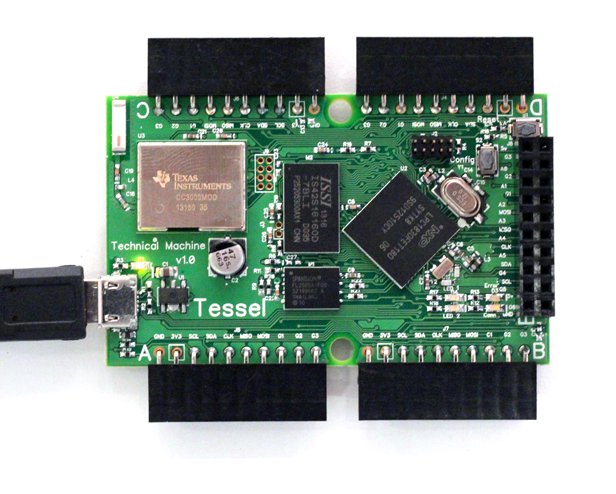People who are proficient with JavaScript or web technologies may not be completely comfortable with programming MCU in assembler and/or C programming language. Node.js, written in JavaScript, seems to be quite popular this days for diverse projects, but technical.io has decided to design a board called Tessel, powered by a Cortex M3 MCU. that can be fully programmed with JavaScript/Node.js.
Tessel hardware specifications:
- MCU – NXP LPC1830 ARM Cortex-M3 @ 180mhz
- System Memory – 32MB SDRAM
- Storage – 32MB Flash
- Connectivity – Wi-Fi via TI CC3000
- Expansion – 16-pin GPIO bank for prototyping
- Power – Micro USB or battery
The board is said to be compatible with 1000’s of Node.js modules from NPM, can be programmed via USB or Wi-Fi using your own IDE, and support Tessel modules, as well as Arduino Shields.
There are two (price) classes for Tessel modules:
- Class A:
- Relay — turn devices on and off (up to 5 amps)
- Temperature/Humidity sensor — get information about the climate
- Servo Driver – make up to 16 little motors move. Includes one servo. (Additional power supply included for US backers)
- Accelerometer — get real-time movement data
- MicroSD Storage — add extra storage to your Tessel (includes a 1GB microSD card)
- Class B:
- RFID (13.56MHz) — read RFID tags
- Bluetooth Low Energy — send data to other devices, i.e. smartphones
- GPS — get location information
- Audio Output — decode and output sound files / raw audio
You can find hardware documentation, JavaScript libraries and sample code in the company’s github repo.
The company is looking for funds for mass production on Dragon Innovation, a new crowdfunding platform, and has already received over $100,000 in pledges. $99 will get your the Tessel board and a Class A modules, whereas $124 is good for the Tessel board and a Class B module. Shipping is expected for February 2014. You can find further information and/or pledge on their campaign page.

Jean-Luc started CNX Software in 2010 as a part-time endeavor, before quitting his job as a software engineering manager, and starting to write daily news, and reviews full time later in 2011.
Support CNX Software! Donate via cryptocurrencies, become a Patron on Patreon, or purchase goods on Amazon or Aliexpress






I have my doubts that 32MB RAM is going to be enough memory for some of the modules in NPM…
Yes it is surprising that you can run node on a platform with those specs. We’ll see when they release the full source.
There is another board with some similarities, albeit lower-spec (on the other hand, it is also much lower-priced) on Kickstarter now.
It is also programmable in Javascript, also runs on an Arm Cortex-M3. Memory is lower (256KB Flash, 48KB RAM), as is clock speed (72 MHz). It doesn’t have Wi-Fi. Price is GBP 19 for one board, or GBP38 for 2 boards+2 NRF24L01+ wireless tranceivers. The board is called Espruino (http://www.kickstarter.com/projects/48651611/espruino-javascript-for-things).
Just for the record, the are not running Node.js. From the FAQ( http://www.dragoninnovation.com/projects/22-tessel ): “What’s running JavaScript under the hood? We’re currently running a custom-built, real time operating system on top of a Lua Runtime. Your JavaScript is compiled to Lua bytecode when you push your code, and that bytecode is run on the runtime. It’s this runtime that allows us to have such low memory overhead. We may switch over to an implementation of Libuv or a microLinux flavor in the future, but that shouldn’t change anything about the user experience with Tessel (except it will be faster!)” They… Read more »